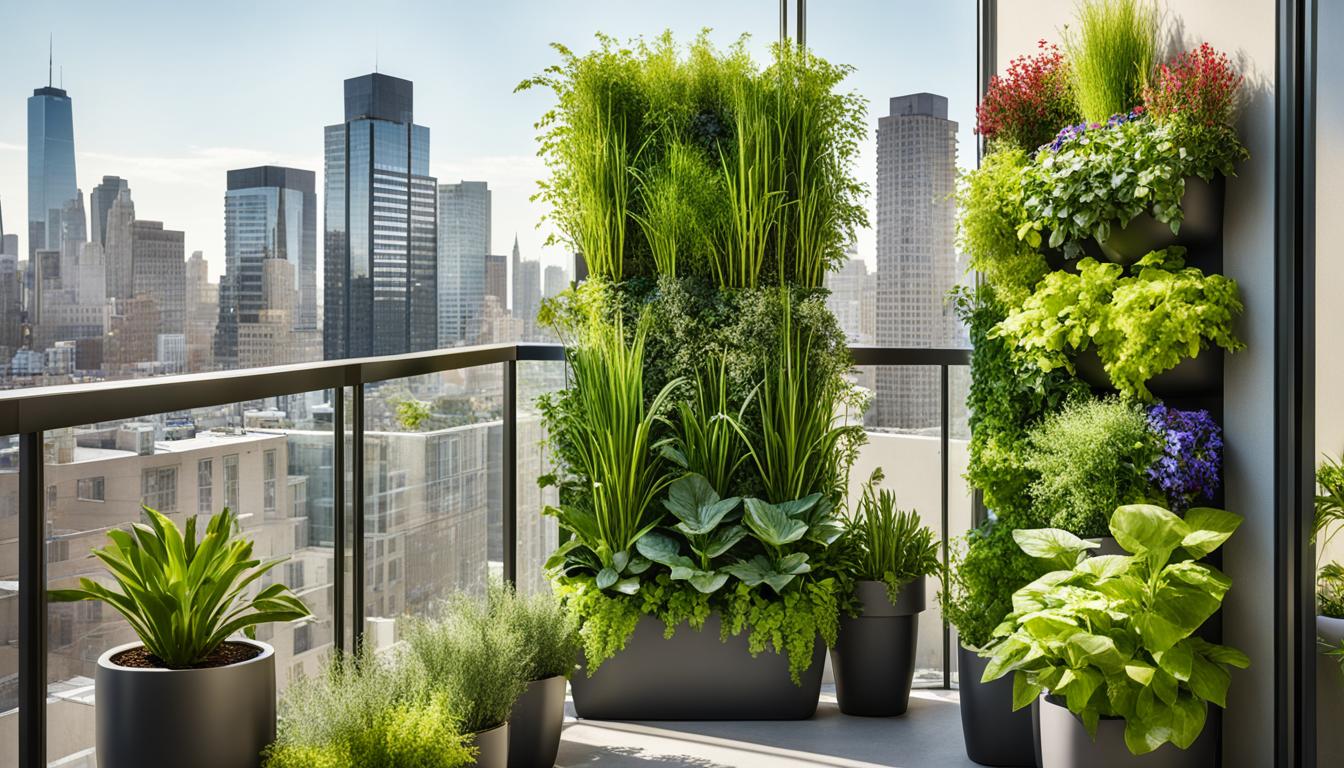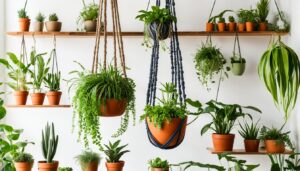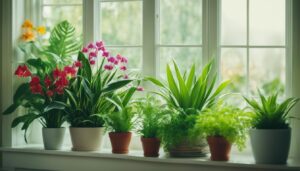If you’re looking to maximize your growing space in a small area of your home, vertical gardening is the perfect solution. Whether you have a tiny backyard or a compact balcony, vertical gardening allows you to utilize vertical space and create a lush oasis of greenery. You can even bring the beauty of the outdoors inside with an indoor vertical garden.
With vertical gardening, you can grow plants upwards, making the most of limited space. It offers numerous benefits beyond just saving space. By growing plants vertically, you’ll have less weeding to do, as plants are lifted off the ground, minimizing weed growth. Better air circulation is another advantage, which can help prevent diseases that spread through the soil. Vertical gardening also makes maintenance and harvesting easier, especially for taller individuals who can reach the plants without bending or crawling.
In this article, we’ll explore the techniques, benefits, and ideas for vertical gardening in small spaces. Whether you’re interested in vining vegetables, fruits, or beautiful flowers, we’ll provide you with the knowledge and inspiration to create your own vertical garden.
Stay tuned for tips on incorporating trellises, stackable planters, terraced gardens, and hanging containers into your vertical gardening endeavors. Let’s explore the possibilities together!
The Benefits of Growing Vertically
Vertical gardening offers numerous benefits beyond just saving space. By growing your plants vertically, you can enjoy the following advantages:
- Less Weeding: Vertical gardening reduces the amount of time spent weeding. Elevating plants off the ground minimizes weed growth, saving you precious time and effort.
- Ample Air Flow: Vertical plants benefit from better air circulation, which helps prevent diseases that spread through the soil. Adequate airflow keeps your plants healthy and thriving.
- Fewer Pests: Growing plants vertically can help deter pests. By keeping your plants lifted and less accessible to crawling insects, you can protect your harvest from potential damage.
- Easy Maintenance: Vertical gardening makes maintenance tasks a breeze. Taller individuals can stand up and reach the plants without bending or crawling, making pruning, watering, and checking for pests much easier.
- Bountiful Harvest: With vertical gardening, you can optimize your yield. Growing plants vertically allows for more efficient use of space, enabling you to cultivate more plants and enjoy a larger harvest.
Take advantage of these benefits by incorporating vertical gardening techniques into your garden or indoor space. Enhance your gardening experience while maximizing your growing potential.
Plants That Thrive in Vertical Gardens
Vertical gardening is a fantastic way to grow vining plants that can climb or be trained to grow upwards. It’s an effective technique that allows you to make the most of your limited space. Whether you’re looking to grow delicious vining vegetables, beautiful flowers, or even fruits, there are plenty of options to choose from.
Vining Vegetables
When it comes to vining vegetables, you’ll be amazed at the variety of choices available for your vertical garden. Here are some popular examples:
| Vegetable | Description |
|---|---|
| Cucumbers | These refreshing and crunchy veggies thrive when grown vertically, allowing them to take up less space. |
| Pole Beans | These fast-growing beans are perfect for vertical gardening, and their colorful pods can create a stunning visual display. |
| Peas | With their delicate tendrils, peas are naturals at climbing and can add a touch of elegance to your vertical garden. |
| Melons | Surprisingly, melons can grow vertically if you provide them with sturdy support. Just imagine plucking a juicy melon from your own garden! |
| Grapes | If you’ve always dreamt of having your own grapevine, vertical gardening is the way to go. Not only will they produce delicious fruit, but they’ll also create a beautiful, lush backdrop. |
| Squash | Squash varieties, such as zucchini and yellow squash, can be trained to grow vertically, saving you valuable space. |
| Luffa | A unique and versatile plant, luffa grows as a vine and produces sponges that can be used for various purposes. |
| Gourds | Gourds come in various shapes and sizes and can be used for decorative purposes. They make for eye-catching additions to vertical gardens. |
| Kiwi | If you’re feeling adventurous, you can try growing your own fuzzy kiwi fruits with a strong trellis or support system. |
| Tomatoes (with support) | While tomatoes are technically fruits, they are often classified as vining vegetables. They can be successfully grown vertically with the help of stakes, cages, or trellises. |
Flowers and Fruits
Vertical gardening isn’t just limited to growing edible plants. You can also incorporate colorful flowers, ferns, succulents, and ivy to enhance the aesthetics of your vertical garden. Here are some options:
- Roses: These classic flowers can add beauty, fragrance, and elegance to any vertical garden.
- Climbing Hydrangea: Known for their stunning blooms and clinging vines, climbing hydrangeas are perfect for vertical growth.
- Honeysuckle: With its sweet scent and attractive flowers, honeysuckle is a popular choice for vertical gardening.
- Wisteria: This beautiful vine produces cascades of fragrant flowers, making it a showstopper in any vertical garden.
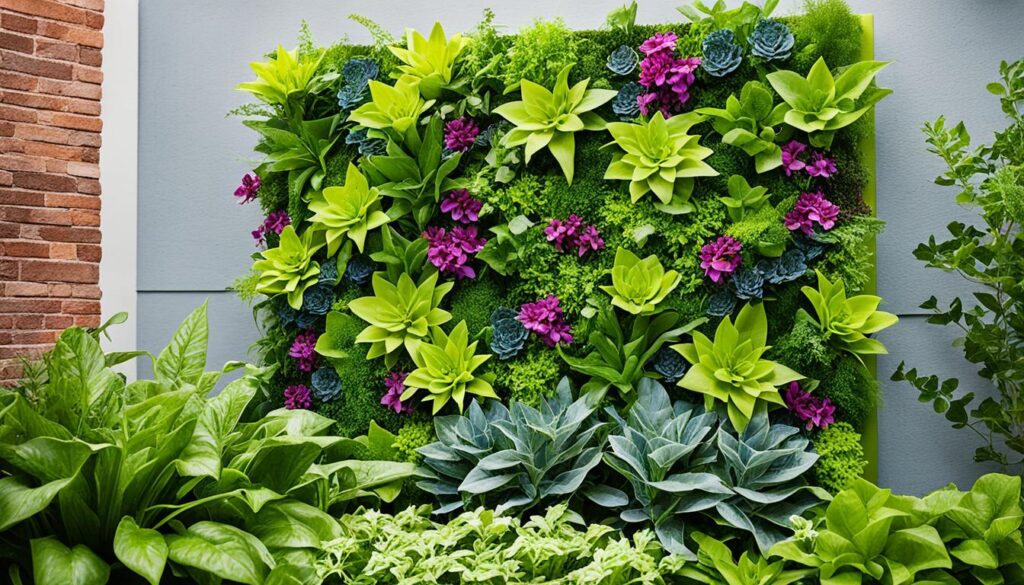
So, whether you’re looking to grow your own fresh produce, create a colorful flower display, or add some greenery to your space, vertical gardening allows you to make the most of your vertical space. With the right plants and a little creativity, you can transform your small space into a thriving oasis of greenery.
Creative Vertical Gardening Techniques
When it comes to vertical gardening, there are numerous creative techniques that you can utilize to make the most of your space. These techniques allow you to grow an abundance of plants in small areas, adding beauty and greenery to your surroundings. Let’s explore some of the most effective techniques for vertical gardening:
Elevated Containers
Elevated containers, such as window boxes, offer a practical solution for vertical gardening. These containers can be mounted on railings or stacked on top of each other to maximize space. Not only do elevated containers provide a designated area for your plants, but they also add an attractive element to your garden.
Hanging Containers
For a visually appealing vertical display, hanging containers are a perfect choice. Simply suspend these containers from hooks or chains, allowing your plants to cascade downwards. Hanging containers are ideal for small spaces, as they effectively utilize vertical space and create a stunning focal point in your garden.
Trellises
Trellises provide essential support for climbing plants, allowing them to grow vertically. You can create trellises using various materials such as wood, plastic, wire, or string. With trellises, you can grow vining plants like tomatoes, cucumbers, and beans, while also adding an aesthetically pleasing structure to your garden.
Green Walls
Green walls are a unique technique that involves attaching small pots or containers to fences or walls. This method creates a vertical garden that adds visual interest and helps you maximize your growing space. Green walls are an excellent choice for individuals looking to create a lush and vibrant garden in limited areas.
Arbors and Archways
Arbors and archways serve a dual purpose in vertical gardening. Not only do they offer vertical gardening space, but they also add architectural beauty to your garden. By incorporating climbing plants such as roses or clematis, you can create a stunning, natural tunnel that provides shade and privacy.
Shelf Systems and Cinderblock Walls
To further maximize your vertical gardening potential, consider utilizing shelf systems and cinderblock walls. These structures provide additional tiers for growing plants vertically, allowing you to create a multi-level garden. Shelf systems and cinderblock walls offer both functionality and aesthetics, as they can be customized to suit your unique style.
By employing these creative techniques, you can transform any small space into a thriving vertical garden. Experiment with different methods, mix and match techniques, and discover what works best for your specific gardening needs.
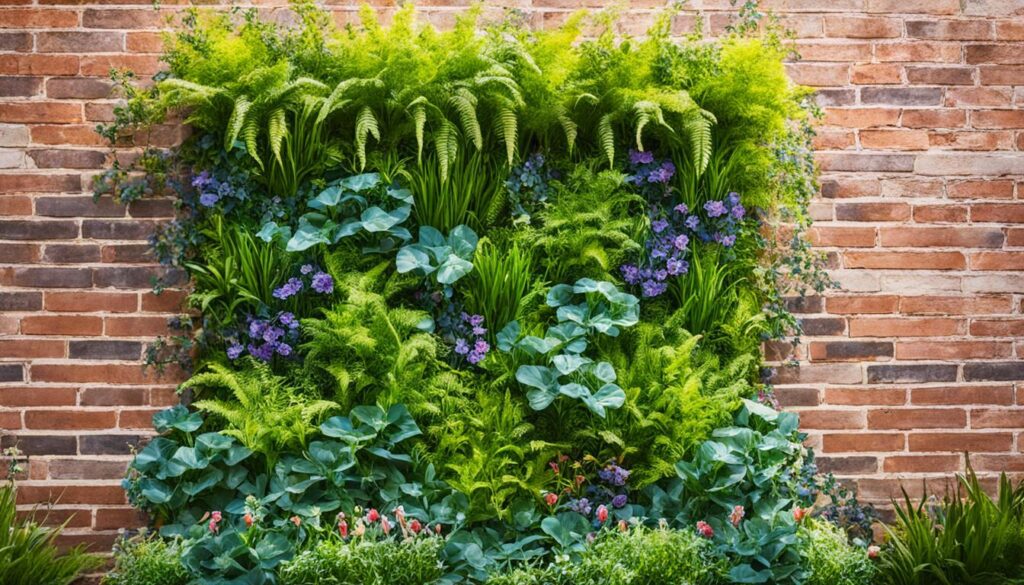
| Techniques | Description |
|---|---|
| Elevated Containers | Containers mounted on railings or stacked to maximize space. |
| Hanging Containers | Containers suspended from hooks or chains, creating a vertical display. |
| Trellises | Support structures made from wood, plastic, wire, or string for climbing plants. |
| Green Walls | Small pots or containers attached to fences or walls, forming a vertical garden. |
| Arbors and Archways | Structures that provide vertical gardening space and architectural beauty. |
| Shelf Systems and Cinderblock Walls | Additional tiers for growing plants vertically, maximizing space. |
Vertical Gardening with Trellises
Trellises are a versatile and space-saving method for growing vining plants vertically. With a trellis or arbor, you can cultivate plants like roses, jasmine, and various vegetables. By training plants to grow on trellises, you can keep them off the ground, promoting better airflow and reducing the risk of fungal and bacterial diseases. Trellises also help deter pests by keeping plants elevated and less accessible to insects. Additionally, trellises can be used for hanging planters, allowing for even more vertical gardening possibilities.
Benefits of Trellis Gardening
- Vertical growth: Trellises enable vining plants to reach their full potential, utilizing vertical space efficiently.
- Increased airflow: By lifting plants off the ground, trellises facilitate better air circulation, reducing the risk of diseases caused by excess moisture and enhancing overall plant health.
- Pest control: Elevating plants via trellises helps keep them out of reach of crawling insects and pests, reducing the risk of damage and infestation.
- Enhanced aesthetics: Trellises add visual interest and vertical dimension to your garden, creating a beautiful backdrop for your vining plants.
“Trellis gardening offers a practical solution for growing vining plants vertically, maximizing your gardening space while providing multiple benefits such as airflow improvement and pest control.” – Gardening Expert
Whether you have limited space, want to create a visually appealing garden, or simply enjoy the convenience and benefits of vertical gardening, trellises are an excellent tool to incorporate into your gardening setup.
| Trellis Gardening Tips | Trellis Styles |
|---|---|
| 1. Choose sturdy trellises made of materials such as wood, metal, or plastic to ensure durability and longevity. | 1. Arch Trellis |
| 2. Position trellises in strategic locations that receive adequate sunlight and allow easy access for maintenance and harvest. | 2. Lattice Trellis |
| 3. Train vining plants to climb and attach to the trellis using soft ties or twine for support. | 3. Fan Trellis |
| 4. Regularly prune and trim plants to keep them within manageable size and shape. | 4. Obelisk Trellis |
| 5. Consider mixing different types of vining plants on a single trellis to create an attractive and diverse garden. | 5. Teepee Trellis |
Stackable Planters for Vertical Gardening
When it comes to vertical gardening, stackable planters are a game-changer. These innovative vertical planter systems provide a space-saving and resource-efficient solution for growing plants in limited areas. With stackable planters, you can maximize your gardening potential by creating a movable vertical garden that fits your unique space and preferences.
Stackable planters come in various tiers, allowing you to vertically stack multiple planters on top of each other. This design enables you to grow a wide range of plants in a compact and organized manner. Whether you want to cultivate small vegetables like strawberries, leafy greens, or herbs, stackable planters offer a versatile solution with minimal space requirements.
One of the significant advantages of stackable planters is their resource efficiency. By using compact containers, stackable planters concentrate essential resources like soil, water, and fertilizer, reducing wastage and ensuring optimal plant growth. You can conserve these resources while still achieving abundant yields and beautiful displays in your vertical garden.
Additionally, stackable planters provide benefits for individuals with limited mobility. These planters are lightweight and easy to move and rotate, allowing for convenient access to all your plants. Whether you have physical limitations or want to adjust the arrangement of your garden for aesthetic or maintenance purposes, stackable planters offer flexibility and ease.
Explore the possibilities of stackable planters for your vertical gardening journey. Embrace their space-saving design, resource-efficient nature, and versatility to create a thriving oasis in even the smallest of spaces.
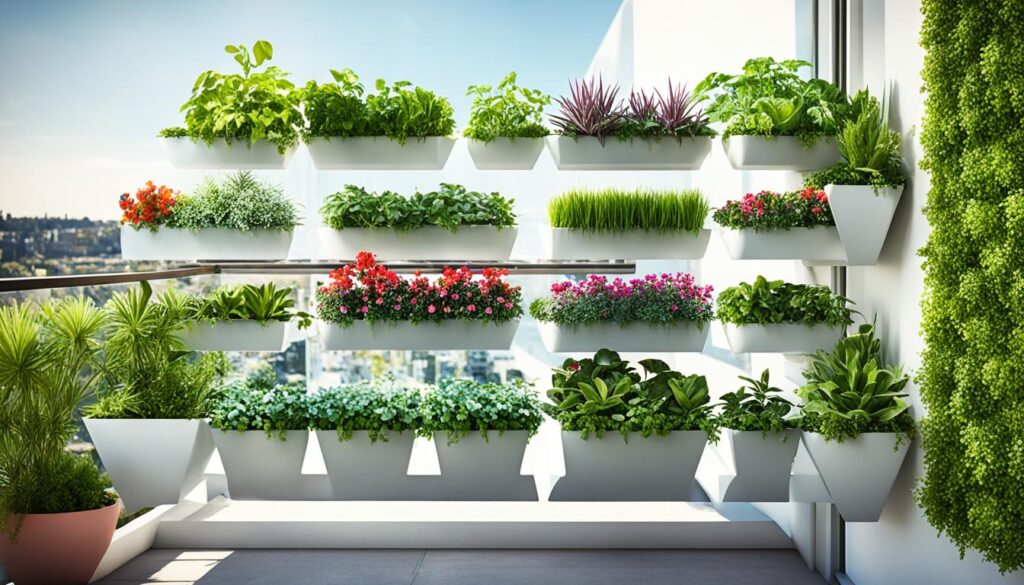
Pros and Cons of Stackable Planters
| Pros | Cons |
|---|---|
| Space-saving | Potential for limited root growth |
| Resource-efficient | Regular monitoring and watering required |
| Easy mobility and rotation | Possible limitations on plant variety |
| Organized and compact | May require additional support for taller plants |
Terraced Gardening for Small Spaces
Terraced gardening is an ancient farming method that offers a unique and effective way to manage diverse plants in small spaces. By creating terraces on slopes or utilizing existing slopes in your yard, you can maximize your gardening potential while conserving space.
One of the key advantages of terraced gardening is the ability to create visually appealing gardens while preventing soil erosion and runoff. The terraces act as barriers, holding soil in place and allowing for better water drainage. This helps to prevent soil erosion, which can be a common issue on sloping landscapes. Additionally, terraced gardens help conserve water by maximizing the utilization of irrigation systems, ensuring that water is efficiently distributed to all levels of the garden.
When planning your terraced garden, it’s important to consider factors such as drainage and sunlight exposure. By strategically placing plants on different levels of the terraces, you can optimize their growing conditions based on their specific needs. This allows you to create microclimates within your garden, accommodating plants that thrive in different light and moisture conditions.
Benefits of Terraced Gardening:
- Conserves space and maximizes gardening potential in small areas
- Prevents soil erosion and runoff
- Efficiently utilizes water irrigation
- Allows for better planning and execution of plant placement based on drainage and sunlight exposure
- Creates visually appealing gardens
Incorporating terraced gardening into your small space can provide numerous benefits, including the ability to manage a diverse range of plants while conserving resources and promoting sustainability.
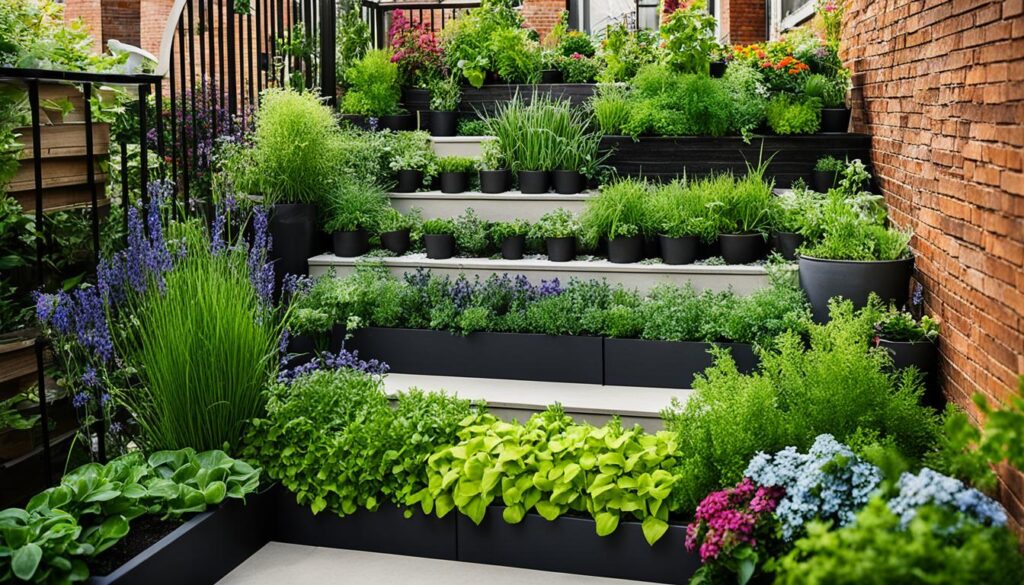
| Plant Placement | Benefits |
|---|---|
| Upper Terrace |
|
| Middle Terrace |
|
| Lower Terrace |
|
Hanging Containers for Easy Vertical Gardening
Hanging containers are a simple and low-cost method for vertical gardening. By installing hooks and suspending pots, you can create a vertical hanging garden in any space with strong support. Hanging containers are particularly suitable for apartments or areas with limited ground space. They provide visual appeal and help keep plants away from common pests and pathogens. Hanging containers also offer easy monitoring and care, as you can closely observe plant growth and address any issues that arise.
Conclusion
Vertical gardening is a practical and innovative solution for small space gardening. Whether you have a tiny backyard, a compact balcony, or even indoor spaces, vertical gardening allows you to maximize your growing potential and create a lush oasis in limited areas.
By utilizing techniques such as trellises, stackable planters, terraced gardens, and hanging containers, you can customize your vertical garden to fit your space and gardening preferences. These techniques offer versatility and flexibility, allowing you to grow a variety of plants, from vining vegetables to colorful flowers.
Indoor vertical gardening is also a great option for bringing greenery into your home and creating a refreshing atmosphere. With vertical gardens, you can enjoy the benefits of improved air quality, reduced stress levels, and a closer connection to nature, even in small living spaces.
Embrace the beauty and advantages of vertical gardening, and transform your small space into a thriving oasis of greenery. With vertical gardening, no space is too small to enjoy the joys and rewards of gardening.
If you happen to be in the area please stop by and say Hi at our shop: The Landscape Connection
and if you are looking for ideas to grow in your gardening knowledge both inside and out you might check in with Michelle @gardeningTLC for great design and gardening ideas.
FAQ
What is vertical gardening?
Vertical gardening is a gardening technique that involves growing plants vertically, utilizing vertical space to maximize growing potential.
What are the benefits of vertical gardening?
Vertical gardening offers several benefits, including saving space, reducing weeding, providing better air circulation, deterring pests, and making maintenance and harvesting easier.
What types of plants can thrive in vertical gardens?
Vining plants such as cucumbers, pole beans, tomatoes, and climbing flowers like roses and wisteria are suitable for vertical gardening. You can also incorporate colorful flowers, ferns, succulents, and ivy for aesthetic appeal.
What techniques can be used for vertical gardening?
There are various techniques for vertical gardening, including elevated containers, hanging containers, trellises, green walls, arbors, shelf systems, and cinderblock walls.
How can trellises be used for vertical gardening?
Trellises are versatile and space-saving. They provide support for vining plants, promote airflow, deter pests, and can also be used for hanging planters.
What are stackable planters and how can they be used for vertical gardening?
Stackable planters are a resource-efficient solution for vertical gardening. You can grow small vegetables like strawberries, leafy greens, and herbs in limited space by stacking the planters.
How can terraced gardening be utilized in small spaces?
Terraced gardening involves creating terraces on slopes or utilizing existing slopes to manage diverse plants. It prevents soil erosion and runoff, promotes water conservation, and makes gardening more accessible.
How can hanging containers be used for vertical gardening?
Hanging containers are a simple and low-cost method for vertical gardening. By suspending pots from hooks, you can create a vertical hanging garden in any space with strong support.
How can vertical gardening be applied to small spaces?
Vertical gardening is a versatile and practical solution for maximizing growing space in small areas. Techniques like trellises, stackable planters, terraced gardening, and hanging containers can be customized to suit your space and gardening preferences.


